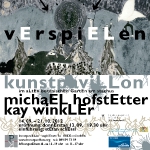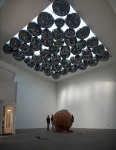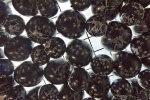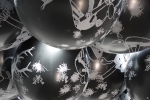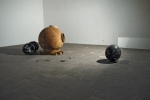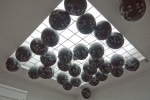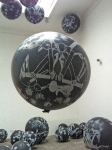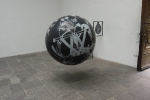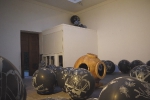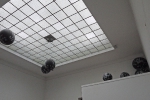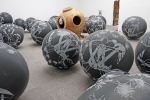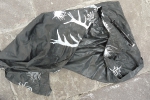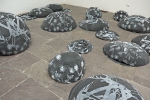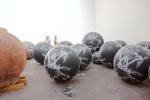verspielen
Michael Hofstetter: sans et avec gaz, 2012
Kay Winkler: Im Grunde grundlos, 2012
Kunstpavillon München, 2012
Dorothée Bauerle-Willert + Shiva Lachen
Erspielen – Verspielen 1
1 Translator’s note: Literally “play and play away” in the sense of “gamble and gamble away”; the German is a wordplay on the different connotations of the verb ‘Spielen’ and the use of particle prefixes to alter the meaning of German verbs.
This is part of the tragedy or the challenge of our contemporary society: Nothing given can be taken for granted. Perhaps even the space in which we live. For modern human beings, rooms have become envelopes, whose locality must be repeatedly re-established.
In “Being and Time” (1927), Martin Heidegger described space as the always already given ground of our Being. Space and Being, for Heidegger, belong together constitutively; it is only the technological distancing of space from our Being that separates anonymous space from the place of our being. Heidegger introduced the notion of the displacement of human beings through modernism into discourse. German fascism answered with its own homespun and practical take on the question. It prescribed half-timbered and gable architecture for the private and more elegant classicism for the prestigious. This return to the Middle Ages and Antiquity by recourse to its clichéd motifs was an attempt to recreate a long-lost world – one enclosed and embedded as historically evolved whole. As part of a total architectural ensemble, the art pavilion in the Munich botanical garden is a manifesto against modernism, and an ambitious attempt to create space as site.
Whether the pavilion should serve as a studio or an exhibition space has even now not been conclusively determined. It was apparently earmarked as a studio for the sculptor Josef Thorak, which Hitler had personally intended to present to him as a birthday gift. Thorak, however, is rumoured never to have used his new studio because of its diminutive 200 m² floor space and 11 m high ceiling. This saga fits in quite well with the neoclassical architecture parlante. There are, nevertheless, clear indications that the pavilion was built as a sculptor’s studio. The most obvious is the allegorical statuary above the main entrance to the pavilion. Joseph Wackerle carved this emblem as a relief in the frame over the southern door. 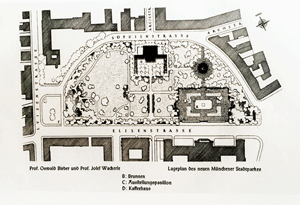 1934, Design for a new garden ensembleIn 1934, he, along with Paul Ludwig Trost and Oswald Bieber, designed this urban ensemble: the old botanical garden, the art pavilion, and the Neptune fountain which bears the sole ascription to Joseph Wackerle. Together with the reliefs in the door frames, it is carved from Kirchheim coquina. Fountain and pavilion refer to each other contrapuntally in their material, symbolic language, and spatial relationship.
1934, Design for a new garden ensembleIn 1934, he, along with Paul Ludwig Trost and Oswald Bieber, designed this urban ensemble: the old botanical garden, the art pavilion, and the Neptune fountain which bears the sole ascription to Joseph Wackerle. Together with the reliefs in the door frames, it is carved from Kirchheim coquina. Fountain and pavilion refer to each other contrapuntally in their material, symbolic language, and spatial relationship.
The free-standing quadratic construction of the pavilion with its massive windowless exterior walls and the four monumental oak doors in the central axes, looks like an oversized pedestal in the garden landscape. The interior light is provided by a skylight, which spans the entire cube. The ponderous solidity of the architecture is opposed to the liquid of the fountain. The other oak doors are also crowned with allegories, where – in addition to sculpture – architecture, painting, and music are immortalized. The style of the allegories, as well as the lack of representation of poetry, point to a conception of art based on Greek-antiquity. In this context, it makes sense that the allegory of painting is not reproduced as a panel painting but as an urn painting. These applications to the minimalist architecture function as a labels, where the symbols of antiquity are intended to evoke its purpose. Together with the neo-baroque fountain, a mixture of styles is revealed, whose principal function is to turn back time. Ludwig Trost was an interior designer of large steamships. Perhaps this is why the pavilion also resembles a piece of gargantuan furniture. Different materials and colours were decoratively combined. The large yellow façade incorporates brown oak portals, which are enclosed within a broad frame of yellow-gray coquina. In the white interior, the ruddy dark gray sandstone of the floor echoes the gray-blue windows of the skylight. Even today, the pavilion is a readable testimony to its claim to being an “eternal setting”, both in its laden symbolism and choice of materials. The building was destroyed during the war. Later, it was rebuilt by an artists’ association. Three of the monumental entrances were walled in to allow continuous vertical surfaces in the interior. The southern door, bearing the allegory of statuary which establishes the relationship to the Neptune fountain, is now the only entrance. Since the 1980s, a sign in neon letters spelling out “Art is not a Luxury” has been placed above this portal. 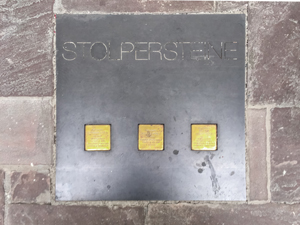 Gunter Demnig, 3 Stumbling BlockIn 2007, 3 memorial block (2) by Gunter Demnig were implanted in the interior.
Gunter Demnig, 3 Stumbling BlockIn 2007, 3 memorial block (2) by Gunter Demnig were implanted in the interior.
2 Translator’s note: In German ‘Stolperstein’ = ‘Stumbling Block’. Raised concrete cubes with brass plates bearing inscriptions of the names of Holocaust victims have been installed all over Europe by the German artist Gunter Demnig beginning in 1992.
Against the background of this brief spatial history, one can begin to see why artists Michael Hofstetter and Kay Winkler chose not to use the art pavilion as a “white cube”, as a neutral background, in order to display their “autonomous” works of art. But how to play with a space that from its inception was anything but playful? One thing was clear to them: In its attempt to calcify itself in millennial eternity, this architectural scene was but a façade of the fascist zeitgeist.
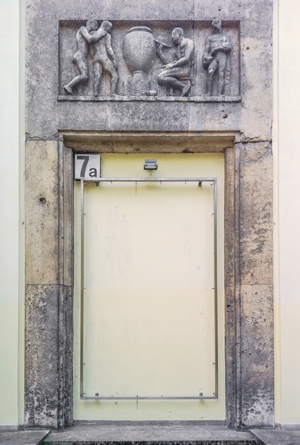 Josef Wackerle, allegory of painting, north door, Kunstpavillon MunichVerspielen is an artistic intervention that pricks the pompous artistic bubble of its architectural hubris and upends its oppressive bulk. Starting from the ideological-intellectual background of this architecture, visible in the exterior relief by Wackerle, the question arises as to how ideas are made material – a problem as old as sculpture itself. And one that modernity solved by excluding ideas from the material realm. The seemingly successful linkage of idea and material, which Wackerle executed in allegories, becomes the main field of tension in the intervention by Hofstetter and Winkler. They expose the fact that this linkage is imposed and arbitrary. At first, they extend it in various ways, forcing the material images to fail on the material level. The relationship between idea and material, which is problematized in their art, is explicitly represented in the allegory of painting on the northern façade. For the painting of Greek urns is not a mere decoration of a vessel, it is a reflection on the relationship between, symbol and substance, or representation and reality.
Josef Wackerle, allegory of painting, north door, Kunstpavillon MunichVerspielen is an artistic intervention that pricks the pompous artistic bubble of its architectural hubris and upends its oppressive bulk. Starting from the ideological-intellectual background of this architecture, visible in the exterior relief by Wackerle, the question arises as to how ideas are made material – a problem as old as sculpture itself. And one that modernity solved by excluding ideas from the material realm. The seemingly successful linkage of idea and material, which Wackerle executed in allegories, becomes the main field of tension in the intervention by Hofstetter and Winkler. They expose the fact that this linkage is imposed and arbitrary. At first, they extend it in various ways, forcing the material images to fail on the material level. The relationship between idea and material, which is problematized in their art, is explicitly represented in the allegory of painting on the northern façade. For the painting of Greek urns is not a mere decoration of a vessel, it is a reflection on the relationship between, symbol and substance, or representation and reality.
The artists stretch this relationship to breaking point. To the point where it bankrupts itself. No false patterns are unmasked, nothing is superimposed. Instead, the space is allowed that which it idiosyncratically demands; to the free play of sign and substance is added another layer of play. Michael Hofstetter and Kay Winkler introduce Bei-Spiele (3) in the literal sense of the German word. It is not a question of a moral confrontation with the historical past, but a process of condensation, displacement, duplication, and parallelization, and also an interrogation of contemporary art discourse itself.
3 Translator’s note: The usual translation of the word ‘Beispiel’ is ‘example’; the play here is on the separation of the word into its particle and base: ‘Bei-Spiel’ = ‘play beside’ or ‘play with’
Via seduction and the appearance of availability in its inherent temporal course, Verspielen terminates in a withdrawal, a denial. For this much is already clear: the promise of symbols always fails with and through the material, whether carved into sculptural motifs, shaped into designs, or whether it is the mere bearer of signs printed or engraved on it. For in Christian reality there is no idea without a material bearer. Even gigabytes of data require a chip to which they cling materially.
Michael Hofstetter’s and Kay Winkler’s play with this ‘space of impossibility’ (4) is above all a condensed conceptual engagement with the architecture of the art pavilion, as well as an extension and a reflection on the space and the location on many complementary levels. In the opening move, Kay Winkler references the Neptune fountain with a gigantic, abandoned, rust-coloured diving bell that lies on the ground under the skylight in the centre of the exhibition space, simultaneously marking the ocean floor and the flow of time in the new field of play. The bell is made from cast treated with iron dust, so resembling iron, and as a material simulacrum also reveals cast as the material from which everything is modelled, and, as such, how any object may be imitated.
4 Translator’s note: The German compound ‘Möglichkeitsraum’ can be translated as ‘opportunity’ or ‘space of possibility’. ‘Unmöglichkeitsraum’ (‘space of impossibility’) is a play on the standard expression.
High above it, as a visual counterweight, Michael Hofstetter sets black rubber balloons afloat, which – staying with the image of the diving bell – bob about on the water’s surface. Against the glass ceiling and inserted into the grid of the skylight window, they are kept aloft by their helium filling. They hang beneath the glass roof in a tapered block. Paradoxically, it darkens the exhibition space. And only in the course of time, drawn down from the ground, do the balloons slowly sink – and it becomes light. Its xenium, which through drawn-down daylight is a Danaë’s gift, since the bringer of light at the same time covers the ground, leaves it blind. An interplay between darkness and light, between concealing and revealing, between cave and knowledge. Analogy and association: Even in an artist’s studio, the materialisation of dreams, visions and images of the imagination, struggle to come to light – or evaporate in the process of translation. The classical Enlightenment model of knowledge becomes unstable: here the work of art is both a mirror and illuminator.
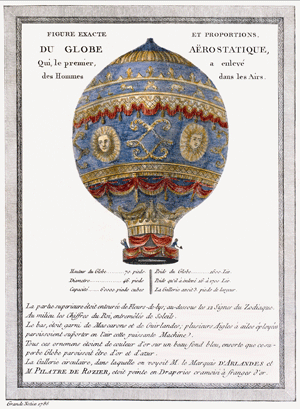 Design of a Montgolfier from 1786The balloons are also associated with the conquest of airspace, the ancient dream of flying into complicated freedom, into metaphysical infinity. The notion that such attempts are a challenge to the gods, a sacrilegious interference in heavenly affairs, comes hot on its heels. Nevertheless, the dream becomes reality and, like Hofstetter’s balloons, the Montgolfier (5) sails with its animals, with duck, chicken and sheep through the sea of the air, drifting like a sailing ship in the wind.
Design of a Montgolfier from 1786The balloons are also associated with the conquest of airspace, the ancient dream of flying into complicated freedom, into metaphysical infinity. The notion that such attempts are a challenge to the gods, a sacrilegious interference in heavenly affairs, comes hot on its heels. Nevertheless, the dream becomes reality and, like Hofstetter’s balloons, the Montgolfier (5) sails with its animals, with duck, chicken and sheep through the sea of the air, drifting like a sailing ship in the wind.
5 Translator’s note: Hot air balloons named for their inventors, the Montgolfier brothers Jacques-Étienne and Joseph-Michel.
In the exhibition room, above and below, water and air, light and dark are parts and participants in an indissoluble play and counter-play. In an osmotic, spontaneous mixing process, in a reciprocal penetration and transformation, different pictorial representations, which are impetus, thrust, and drive, float towards further wide horizons. Aviation and diving are, of course, also attempts to cross the boundaries of human space, a wishful image of overcoming physical restriction. They bear witness to the longing for the other, the unknown, the abyss, which is as seductive as it is menacing. The question of what world lies beyond the horizon and at the bottom of the ocean is at the same time a journey of exploration of the gaze, which, by means of a diving-bell and flying-machine, with renewed attention and with other methodological apparatuses, infiltrates the unconscious or semiconscious in memory of the submerged, multiform, legacies of the past.
The diving bell and the flying-machine also serve as instruments for extensive, extended world traffic; Aristotle mentions this invention, and 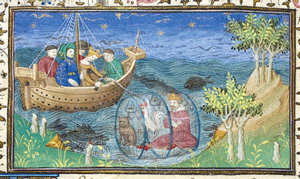 Alexander the Great, diving bell, illustration was supposed to have ascended in a carriage drawn by griffins, immediately afterwards to descend by means of a glass bell to the seabed: conquests of inaccessible elementary regions, ascension and descent in the historically documented imaginary. In some versions of these fabulous stories, Alexander is abandoned by his helpers. Alexander saves himself with a very peculiar trick: he kills a dog, specially brought along for the purpose, from whose blood “it is well known” the salt water recoils (6) The bell is once again free.
Alexander the Great, diving bell, illustration was supposed to have ascended in a carriage drawn by griffins, immediately afterwards to descend by means of a glass bell to the seabed: conquests of inaccessible elementary regions, ascension and descent in the historically documented imaginary. In some versions of these fabulous stories, Alexander is abandoned by his helpers. Alexander saves himself with a very peculiar trick: he kills a dog, specially brought along for the purpose, from whose blood “it is well known” the salt water recoils (6) The bell is once again free.
6 See Alexander Demandt, „Alexander der Große, Leben und Legende“, München 2009, S.311
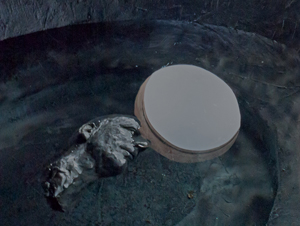 Kay Winkler, M, 2012In these sculptural images, the two artists update the myth and add a new creation, bringing past and present into oscillating interaction. In the following move, the ancient, intricate relationship between analysis and poetry, between construction and mimesis, is introduced by Winkler with the bust of his fellow-artist Hofstetter in black wax. It swims in daring displacement of relationship and purpose in the water inside the great diving bell. The fragility, the plasticity of the wax material, the changement between fragment and totality, the intractable vitality that this head accrues in light and shadow, are the traces of an Energon, and appear like an archaeology of the wish to bring something to light: a dialectical image of an untimely object, current practice, and old technology collapse into one – in analogy to the world, space, and head: “The heavenly vault appears almost to me as the innermost of an immense skull, and we as its crickets!” (7)
Kay Winkler, M, 2012In these sculptural images, the two artists update the myth and add a new creation, bringing past and present into oscillating interaction. In the following move, the ancient, intricate relationship between analysis and poetry, between construction and mimesis, is introduced by Winkler with the bust of his fellow-artist Hofstetter in black wax. It swims in daring displacement of relationship and purpose in the water inside the great diving bell. The fragility, the plasticity of the wax material, the changement between fragment and totality, the intractable vitality that this head accrues in light and shadow, are the traces of an Energon, and appear like an archaeology of the wish to bring something to light: a dialectical image of an untimely object, current practice, and old technology collapse into one – in analogy to the world, space, and head: “The heavenly vault appears almost to me as the innermost of an immense skull, and we as its crickets!” (7)
7 Christian Dietrich Grabbe, “Marius and Sulla”, in: “Dramatische Dichtungen”, Frankfurt am Main 1827, p. 307
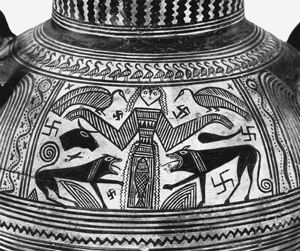 Potnia Theron, antique vase paintingThe Boötean urn painting of Potnia Theron on the balloons is a comment on this artificial artist’s head floating in the water. Potnia Theron, once the mistress of the animals, is portrayed here as a copulating double figure, ornamentally arranged among mystical animals and modern viruses. We notice that these animals are not of the same kind as those who had to serve as the first passengers on the maiden voyage of the Montgolfier. On the balloons are creatures in a transient alliance between animal and man. In the Montgolfier, there are already things, test objects whose loss would have been bearable in the event of the failure of this mission.
Potnia Theron, antique vase paintingThe Boötean urn painting of Potnia Theron on the balloons is a comment on this artificial artist’s head floating in the water. Potnia Theron, once the mistress of the animals, is portrayed here as a copulating double figure, ornamentally arranged among mystical animals and modern viruses. We notice that these animals are not of the same kind as those who had to serve as the first passengers on the maiden voyage of the Montgolfier. On the balloons are creatures in a transient alliance between animal and man. In the Montgolfier, there are already things, test objects whose loss would have been bearable in the event of the failure of this mission.
The central figure in this exhibition is the sphere. This elementary form is the hinge both between the two artists, as well as between the art production and its reception. The sphere as a diving bell, balloon, and head gives the exhibition form, shape, and extension. Functioning simultaneously as a projection screen, it enables a complex image mesh that extends through the interaction of the three spherical shapes into infinity. The spherical shape is a central symbol of Western culture, extending far back: in Genesis, the creation of the human being is first of all the creation of a vessel, a moulded hollow space that becomes a living being only through an act of inspiration. 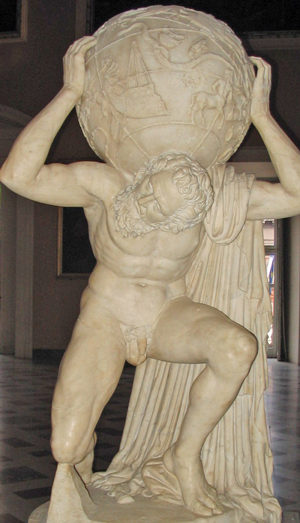 Varnese atlas, 2nd centuryCreation is described here as a communicative alliance in the pneumatic act – and the animation of inert matter always occurs in the process of incarnation and contemplation: “You live and do nothing to me” (8) – the note by Aby Warburg not only embraces the salvation of moving Others through calm composition and the tension between living experience and rational distancing in the work of art, but also the emergence of structures of meaning. And throughout, the ping-pong between the two artists could well be understood as a miraculous pact. A new piece of information may emerge from each visual movement between the individual elements. Relations with nodes, linkages, connecting lines are always re-emerging, and, as in a network, familiar images with heterogeneous and completely unexpected elements are captured. Signs, which, as it were, subvert narrative, form the basis of the images.
Varnese atlas, 2nd centuryCreation is described here as a communicative alliance in the pneumatic act – and the animation of inert matter always occurs in the process of incarnation and contemplation: “You live and do nothing to me” (8) – the note by Aby Warburg not only embraces the salvation of moving Others through calm composition and the tension between living experience and rational distancing in the work of art, but also the emergence of structures of meaning. And throughout, the ping-pong between the two artists could well be understood as a miraculous pact. A new piece of information may emerge from each visual movement between the individual elements. Relations with nodes, linkages, connecting lines are always re-emerging, and, as in a network, familiar images with heterogeneous and completely unexpected elements are captured. Signs, which, as it were, subvert narrative, form the basis of the images.
8 Thus the motto of Warburg’s fragments for a psychology of art,
Quoted in: Gombrich, “Aby Warburg: an intellectual biography”, London 1970, p. 98.
... The ‘symbolically connecting man’ forms the link between the totemic ‘griffin man’ and the abstract-logical ‘human being’. Images and symbols are, according to Warburg, designed affects. They are memories of the phobic energy that continues to live in them. At the same time, they create adistance from their origin. The fear is objectivized and shaped, the origin of fear named and thus also banished again. The fear is present in the image or symbol, but in contrast to the totem or the fetish, the viewer no longer equates it with their object. This is what Warburg means when he says, “You live and do nothing to me”
From: “1. Idea non vincit. Warburg and the crisis of liberal modernity”
In: Fernando Esposito, “Mythical Modernity: Aviation, Fascism and the Longing for Order in Italy and Germany”, Basingstoke 2015 p.81.
Michael Hofstetter and Kay Winkler reflect different modes of thinking in bemusing simultaneity. The two titles point the way. Hofstetter works with indexical references that we recognise from photography. His title, "avec et sans gaz", lays a trace to Duchamp’s work, Étant donnés, in whose expanded forms, we also discover just what is given in this work: "1° la chute d’eau, 2° le gaz d’éclairage ..." Winkler’s title, "Im Grunde grundlos" on the other hand, refers poetically to something fundamental: to the beginning that can never be established. That every beginning is a positing from nothingness. A positing which is abrogated in Gesetztsein (9) [essential principle] in the double sense of the word.(10) Winkler questions the horizon of artistic activity and how the work itself creates
its own horizon. For every work is, at the same time, containing and contained.
9 Translator’s note: ‘Gesetztsein’ can be translated roughly as ‘essence of law or principle’, but in German there is a pun on the two parts of the compound ‘Gesetzt/sein’: ‘gesetzen’ to ‘posit’ and ‘sein’ = ‘be’, thus ‘be posited’.
10 Conversely, Being is as being from the essence of ground [Translators’ note: Also ‘Reason/Cause’]. Ground and Being are the same, not identical, which is already indicated by the difference between the names “Being” and “ground.” Being is in “essence”: ground. Therefore, Being can never first have another ground as its justification. Accordingly, ground is removed from Being. Ground remains distinct from Being. In the sense of such a departure from the ground of Being, “Being” is the Ab-Grund (Translators’ note: ‘abyss’ but also ‘gap’ and literally ‘away ground’). Insofar as Being as such is in itself ‘grounding’, it remains groundless. “Being” does not fall within the sphere of power of the proposition, but only of its being there.
Martin Heidegger, “The Principle of Sufficient Reason”, Tübingen 1969, p. 94 ff
The two play with these different representational levels in mutually productive friction. Sometimes, one has the impression as an art historian of falling for the two artists’ tricks – following the pathos and the indexical references which form a mutually reinforcing reservoir of movements and emotions and draw one enchanted through time: fossils in motion, which move us, and which can transform our perception. The movement itself is at the centre of this work in all the chains of associations that arise. For the inherent temporality of this intervention ultimately makes a place of the space, and a sculpture from the play. For “the collapse of Being into space is only possible on the ground of ecstatic horizontal temporality.”(11)
11 Martin Heidegger, “Being and Time”, Tübingen, 1986, p.369.
In short, the two artists create a turbulent density, in which each discrete entity becomes ambiguous. The form, the formality of the entire ensemble from the process of approach and removal, of twists and spirals, are the property of all thinking. The memory of the blood sacrifice of Alexanders’ dog lies under the gaze of the as-if-decapitated head. Potnia Theron, in turn, is a deity of antiquity who is the mistress of wild animals, but also of fabulous beings and hermaphroditic forms. She perceives victims and perpetrators in a symbiotic relationship. She is a huntress and at the same time protector. In conversions, new formulations, and reformulations, in Homer she becomes Artemis, who drives her twin brother Apollo to fight Poseidon, the god of the sea, wherein the diver’s bell again comes into play:
But his sister then reacted bitterly, the mistress of the game,
Artemis, who raced through the floods, and scornfully began:
“Really, O excellent archer, you would flee, and gift Poseidon
Total victory and lightly gained honour?” (12)
12 Homer, “Iliad”, 21. Song
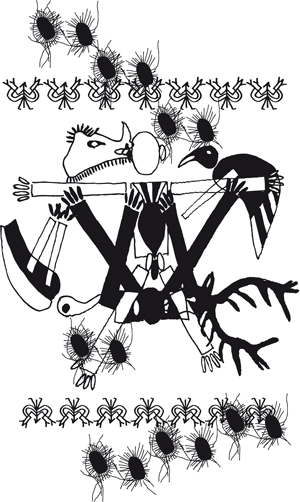 Michael Hofstetter, sketch for the silkscreen print on balloonIn the ancient pictorial representations of Potnia Theron, the dualism of male and female resonates with the idea of fertility and reproduction, and thus a complex relationship between past, present, and future.
Michael Hofstetter, sketch for the silkscreen print on balloonIn the ancient pictorial representations of Potnia Theron, the dualism of male and female resonates with the idea of fertility and reproduction, and thus a complex relationship between past, present, and future.
In Hofstetter’s drawing of the mistress of the animals, the self-copulation of this dualism is rescinded for a moment in self-sufficiency. Her image, however, may also undergo a mythological update through the visual connection with the head, when we think of the legend of Salome, which in its turn is a complex and ambivalent web. In many versions, her erotic demonism, her deadly purpose, comes into being only through the rejection of Jochanaan; henceforth, she settles in the intermediate sphere between woman and predator. Hofstetter’s depiction, however, is not a generic history painting, but a stylization and abstraction, a transcendence of history into the present, which points to the indissoluble entanglements between antitheses that make up our lives.
In the interplay of distant proximity and near distance, of different perspectives, of times and spaces, in the complex, in the obvious, as well as in the subcutaneous interweaving of images,
there is always a double presence, the twofold order of the work of art: the sculptural elements of the exhibition exist and subsist for themselves, are a self-evident object, but at the same time they are part of a larger context which, however, only arises when the thing and the fragments of thought are brought together in being observed. In this space of the image, the two artists undertake a journey into space-time, into the history and memory of worlds. In their artistic reflection, they span “the threads that connect us with the world in order to make them appear.”(13)
13 Maurice Merleau-Ponty, “Phenomenology of Perception”, Berlin, 1966, p. 10
Pictures are mobile and mobilising. Like the Metaphorai, the communal transport of Athens, they traverse and organize places(14), and this is the reason why they have developed their own practices. Images and representations also traverse the history of their producers, they come from far away, they cross cultural spaces, cross the limits of nature and culture, of anthropology and history. They cross the history of the media in which they are updated in a new attire. In space as site, we read time, and all Being is passed through. Space together with the brain “is a palimpsest ... Countless layers of images, representations, and feelings have been placed one by one upon your brain as gently as light. Each of these layers seemed to enshroud what came before. But none has actually perished.”(15)
14 See also: Michel de Certeau, “The Art of Action”, Berlin 1988, p. 215
15 Charles Baudelaire, “The Palimpsest”, 1860;
„Qu‘ est-ce que le cerveau humain, sinon un palimpseste; immense et naturel? Mon cerveau est un palimpseste et le vôtre aussi, lecteur. Des couches innombrables d‘idées, d‘images, de sentiments sont tombées successivement sur votre cerveau, aussi doucement que la lumière. Il a semblé que chacune a enseveli la précédente. Mais aucune en réalité n‘a péri.“
Quoted in Harald Weinrich: “How civilized is the devil?: Short visits to good and evil”, 2007, München, p. 30
Verspielen (gaming away) foams up the traces and signs into symbols – also through their historical sediment. Its accession takes this play from the engraved allegories at the scene of the exhibition itself. Its dissolution takes place through temporal progression – a product of its experimental design. The helium pumped into the balloons escapes. They literally run out of breath. At the end of the exhibition they lie inert as black rubber rags on the ground of reality. Only a renewed pneumatic breathing, a new enthusiasm, a new imaginary charge would give them back form and flight, and thus the possibility of movement and play.
In the diving-bell, the water has become dirty and oily, and mostly evaporated. The head, stripped of its artificial elements, eventually becomes a piece of flotsam at the bottom of the bell.
This night-painting, this post-apocalyptic state, is not a pathetic setting, but the aleatory result of an entropic course, which deliberately contrasts with the fascist ensemble, whose fixation is duration. A course that all material – and the symbols conveyed by this material – takes. Thus the prefix “Ver” has jumped aboard “Spiel”. A game in which the given game is played out to its conclusion – until the rules of the game lie exposed.
Dorothée Bauerle-Willert
Shiva Lachen
